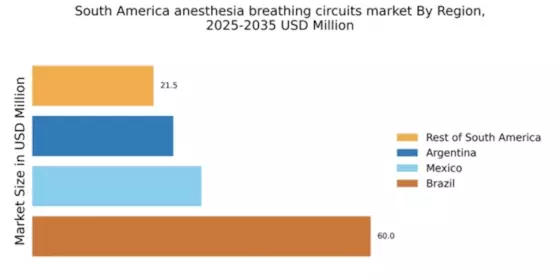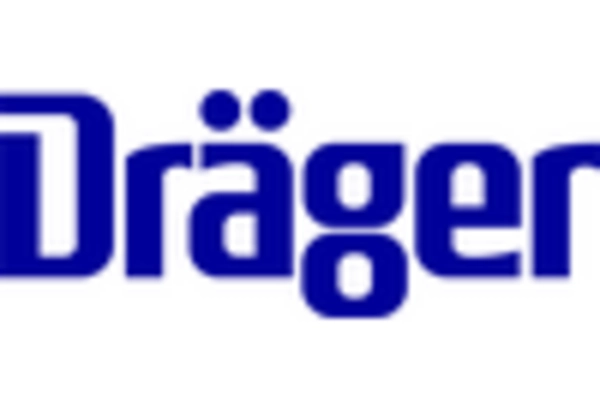Surge in Surgical Interventions
The surge in surgical interventions across South America is significantly impacting the anesthesia breathing-circuits market. With an increase in both elective and emergency surgeries, the demand for effective anesthesia management systems is on the rise. Reports indicate that surgical procedures in countries like Argentina and Colombia have increased by over 15% in recent years, driven by advancements in surgical techniques and an aging population requiring more medical attention. This growing volume of surgeries necessitates the use of reliable anesthesia breathing circuits to ensure patient safety and comfort. Consequently, the anesthesia breathing-circuits market is likely to experience robust growth as healthcare providers strive to meet the rising demand for surgical services.
Increasing Healthcare Expenditure
The rising healthcare expenditure in South America is a pivotal driver for the anesthesia breathing-circuits market. Governments and private sectors are investing more in healthcare infrastructure, which includes the procurement of advanced medical equipment. For instance, Brazil's healthcare spending has seen an increase of approximately 10% annually, reflecting a growing commitment to improving healthcare services. This trend is likely to enhance the demand for anesthesia breathing circuits, as hospitals and surgical centers seek to upgrade their facilities. Furthermore, as healthcare budgets expand, there is a corresponding increase in the number of surgical procedures performed, which directly correlates with the need for efficient anesthesia delivery systems. The anesthesia breathing-circuits market is thus poised to benefit from this upward trajectory in healthcare investment.
Expansion of Healthcare Facilities
The expansion of healthcare facilities across South America is a crucial driver for the anesthesia breathing-circuits market. New hospitals and surgical centers are being established to meet the growing healthcare demands of the population. For example, countries like Chile and Peru are witnessing a rapid increase in the number of healthcare institutions, which is expected to rise by 20% in the next five years. This expansion necessitates the procurement of modern anesthesia equipment, including breathing circuits, to ensure high-quality patient care. As these facilities become operational, the anesthesia breathing-circuits market is likely to see a corresponding increase in demand, driven by the need for reliable and efficient anesthesia delivery systems.
Growing Awareness of Patient Safety
There is a growing awareness of patient safety and quality of care in South America, which is influencing the anesthesia breathing-circuits market. Healthcare professionals and institutions are increasingly prioritizing the use of high-quality, reliable anesthesia equipment to minimize risks associated with surgical procedures. This heightened focus on patient safety is reflected in the adoption of advanced breathing circuits that offer better performance and reliability. As a result, hospitals are more inclined to invest in superior anesthesia systems, which could lead to a market growth rate of around 8% annually. The anesthesia breathing-circuits market is thus likely to expand as healthcare providers align their practices with the evolving standards of patient care.
Technological Innovations in Medical Devices
Technological innovations in medical devices are driving transformation within the anesthesia breathing-circuits market. The introduction of smart breathing circuits equipped with sensors and monitoring capabilities enhances the efficiency and safety of anesthesia delivery. In South America, manufacturers are increasingly focusing on developing advanced products that integrate with existing hospital systems, thereby improving workflow and patient outcomes. The market for these innovative devices is projected to grow by approximately 12% over the next few years, as healthcare facilities seek to adopt cutting-edge technologies. This trend indicates a shift towards more sophisticated anesthesia management solutions, positioning the anesthesia breathing-circuits market for substantial growth.


















Leave a Comment